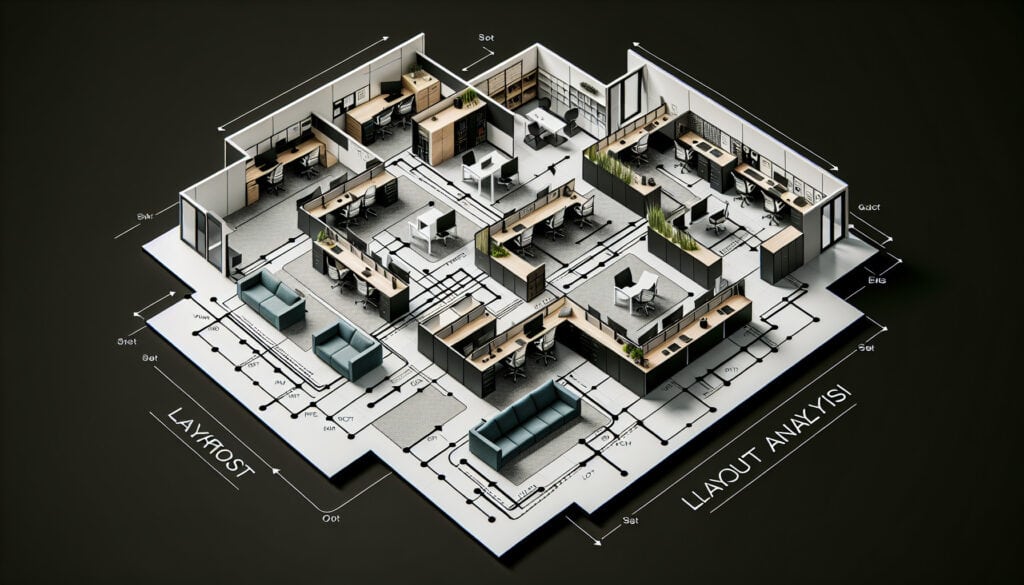To analyze and optimize the layout of a physical space.
- 方法: 客户与营销, 经济学, 产品设计
Layout Analysis

Layout Analysis
- 持续改进, 面向制造设计 (DfM), 效率, 人体工程学, 精益制造, 工艺优化, 生产率, 模拟
目标
如何使用
- The process of analyzing the layout of a physical space, such as a factory floor or an office, to improve efficiency, safety, and productivity. It often involves using tools like flow diagrams and simulation to model the movement of people and materials.
优点
- Can improve efficiency and reduce costs; Can improve safety and ergonomics.
缺点
- Can be time-consuming and complex to perform; May require specialized software and expertise.
类别
- 人体工程学, 制造业
最适合:
- Optimizing the layout of a factory floor or an office to improve efficiency and safety.
Layout Analysis serves as a strategic approach in various industries, including manufacturing, warehousing, healthcare, and office environments, where optimizing spatial arrangements can lead to enhanced workflows and better resource utilization. In the context of a factory floor, this methodology is typically employed during the design or re-evaluation phase, where engineers and operations managers collaborate to assess current layouts using tools like process flow diagrams. By modeling the movement of materials and personnel, bottlenecks can be identified and addressed, decreasing cycle times and minimizing waste. In offices, layout analysis can be conducted to enhance collaboration and productivity by arranging workstations and meeting areas to promote effective communication among teams. Participants may include facility planners, ergonomics experts, and safety officers who work together to ensure the space meets both operational needs and workplace safety regulations. Hospitals often utilize layout analysis to optimize patient flow, reduce wait times, and enhance the overall care experience, which can lead to better health outcomes. Using simulation tools allows stakeholders to experiment with different configurations virtually, leading to data-driven decisions that can significantly decrease costs associated with downtime and safety incidents while improving employee morale through ergonomically friendly designs. Implementing effective layout analysis fosters an environment conducive to continuous improvement, contributing to long-term operational success.
该方法的关键步骤
- Identify critical workflows and processes within the space.
- Map current layout using flow diagrams to visualize movement patterns.
- Analyze circulation paths for efficiency, safety, and ergonomics.
- Identify bottlenecks or obstacles that impact workflow.
- Evaluate space utilization and storage efficiency.
- Engage simulation tools to model proposed layout changes.
- Test layout alternatives through simulations to assess impact.
- Refine layout options based on simulation outcomes and feedback.
- Implement the chosen layout with necessary modifications.
- Monitor performance metrics and adjust the layout as needed.
专业提示
- Integrate 精益原则 by mapping value streams to eliminate waste and enhance workflow efficiency in layout design.
- Employ continuous simulation tools to assess dynamic interactions between workers and materials, optimizing movement pathways.
- Incorporate ergonomic evaluations into layout decisions, ensuring workstations support user health and safety while maximizing productivity.
历史背景
1949
1950
1950
1960
1960
1960
1960
1940
1950
1950
1958
1960
1960
1960
1960
(如果日期不详或不相关,例如 "流体力学",则对其显著出现的时间作了四舍五入的估计)。















相关文章
制造运营管理(MOM)
制造执行系统(MES)
生产控制计划
人工测试
手动搬运评估表 (MAC)
手动任务风险评估工具(ManTRA)